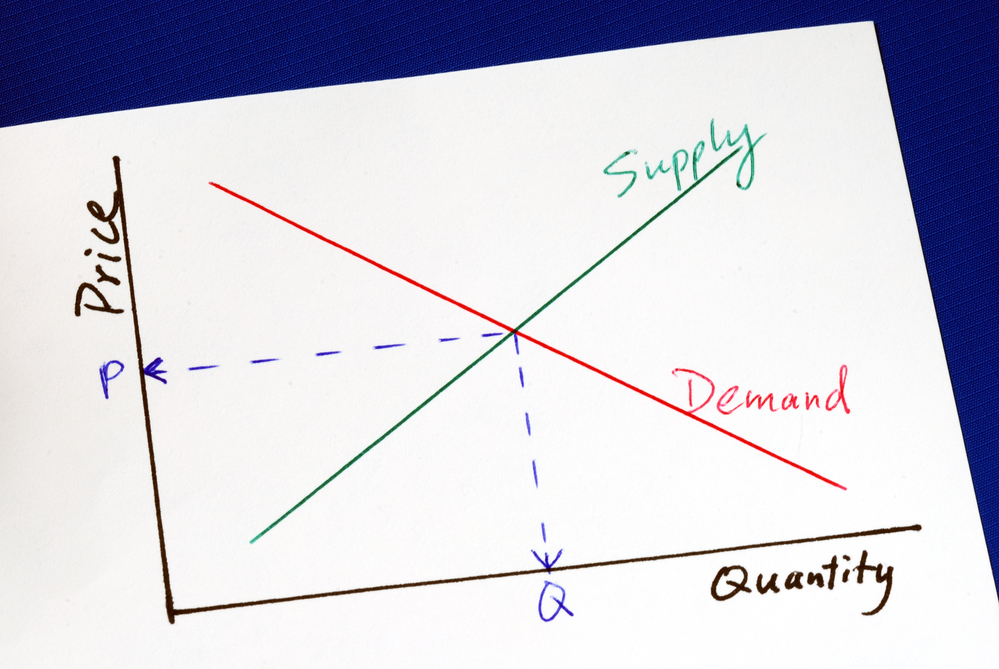Supply
Definitions and Basics
Supply, from the Concise Encyclopedia of Economics
The most basic laws in economics are the law of supply and the law of demand. Indeed, almost every economic event or phenomenon is the product of the interaction of these two laws. The law of supply states that the quantity of a good supplied (i.e., the amount owners or producers offer for sale) rises as the market price rises, and falls as the price falls. Conversely, the law of demand (see Demand) says that the quantity of a good demanded falls as the price rises, and vice versa. (Economists do not really have a “law” of supply, though they talk and write as though they do.)
One function of markets is to find “equilibrium” prices that balance the supplies of and demands for goods and services….
Economists often talk of “demand curves” and “supply curves.” A demand curve traces the quantity of a good that consumers will buy at various prices. As the price rises, the number of units demanded declines. That is because everyone’s resources are finite; as the price of one good rises, consumers buy less of that and, sometimes, more of other goods that now are relatively cheaper. Similarly, a supply curve traces the quantity of a good that sellers will produce at various prices. As the price falls, so does the number of units supplied. Equilibrium is the point at which the demand and supply curves intersect–the single price at which the quantity demanded and the quantity supplied are the same….
Why does the quantity supplied rise as the price rises and fall as the price falls? The reasons really are quite logical. First, consider the case of a company that makes a consumer product. Acting rationally, the company will buy the cheapest materials (not the lowest quality, but the lowest cost for any given level of quality). As production (supply) increases, the company has to buy progressively more expensive (i.e., less efficient) materials or labor, and its costs increase. It charges a higher price to offset its rising unit costs….
Supply and Demand, at SocialStudiesforKids.com.
One of the most basic concepts of economics is Supply and Demand. These are really two separate things, but they are almost always talked about together.
Supply is how much of something is available. For example, if you have 9 baseball cards, then your supply of baseball cards is 9. If you have 6 apples, then your supply of apples is 6.
Demand is how much of something people want. It sounds a little bit harder to measure, but it really isn’t. To measure demand, we can use a very simple numbering system, just like the supply one. If 8 people want baseball cards, then we can say that the demand for baseball cards is 8. If 6 people want apples, then we can say that the demand for apples is 6.
In the News and Examples

Trey Malone and Jayson L. Lusk, No Yolk: Shortages and Spikes in the Time of COVID, at Econlib, May 3, 2021.
…empty grocery store shelves and panicked shoppers have become the sine qua non of the pandemic’s disruptions. Eggs, a common staple food, experienced some of the most dramatic price increases… A common conclusion is that America’s food supply chain is “broken” and in need of radical restructuring to become resilient. This view is almost completely at odds with the facts and misunderstands the nature of the disruptions and the speed at which the food system responded.
Lisa Turner on Organic Farming. EconTalk Podcast episode, December 2012.
Lisa Turner of Laughing Stock Farm talks with EconTalk host Russ Roberts about life as a small organic farmer. She describes her working day, the challenges of farming, the role of the U.S. Department of Agriculture in her life and what some job applicants who want to work on her farm need to understand about business.
O’Donohoe on Potato Chips and Salty Snacks, podcast episode on EconTalk. August 22, 2011.
Brendan O’Donohoe of Frito-Lay talks with EconTalk host Russ Roberts about how potato chips and other salty snacks get made, distributed, and marketed. The interview follows an hour-long tour of a local supermarket where O’Donohoe showed Roberts some of the ways that chips and snacks get displayed and marketed in a modern supermarket. The conversation is a window into a world that few of us experience or are even aware of–how modern producers and retailers make sure the shelves are stocked and their products get noticed.
Richard McKenzie on Prices, podcast episode on EconTalk. June 16, 2008
Richard McKenzie of the University California, Irvine and the author of Why Popcorn Costs So Much at the Movies and Other Pricing Puzzles, talks with EconTalk host Russ Roberts about a wide range of pricing puzzles. They discuss why Southern California experiences frequent water crises, why price falls after Christmas, why popcorn seems so expensive at the movies, and the economics of price discrimination.
Experimental Economics, from the Concise Encyclopedia of Economics
Economic theory in its simplest incarnation of supply and demand makes a strong set of predictions. Consider a graph (see Figure 1) that has price on the vertical axis and quantity on the horizontal axis. The supply schedule answers the question: How many units would voluntarily be brought to the market at various prices? Thus, supply in this experimental structure is an ascending stair-step pattern that starts at $10 and rises $2 per step for each unit in the market. Above $18 the supply curve is vertical, for only five units can ever be purchased in this setting. Likewise, the demand schedule answers the question: How many units will be voluntarily purchased in the market at different prices? Using the same analysis as that for the sellers, we find that the demand schedule is a descending stair-step pattern that starts at $22 and falls $2 per step for each unit demanded in the market. Below a price of $14, the demand schedule also is vertical, for no more than the five units are desired in this setting. For this scenario, textbook economics predicts that equilibrium will be reached where supply equals demand. In this case, that means that four units would be traded at the identical price of $16….
A Little History: Primary Sources and References

Adam Smith’s famous “invisible hand” quotation refers to the fact that changes in market prices elicit changes in supply in a natural way. However, in the actual quotation he goes further. He emphasizes that those supply changes are beneficial not only to the individual’s self-interest, but also to the public interest by benefiting the purchasers of the supplier’s goods. Of Restraints upon the Importation from Foreign Countries, by Adam Smith. Book IV, Chapter 2 of the Wealth of Nations
… As every individual, therefore, endeavours as much as he can both to employ his capital in the support of domestic industry, and so to direct that industry that its produce may be of the greatest value; every individual necessarily labours to render the annual revenue of the society as great as he can. He generally, indeed, neither intends to promote the public interest, nor knows how much he is promoting it. By preferring the support of domestic to that of foreign industry, he intends only his own security; and by directing that industry in such a manner as its produce may be of the greatest value, he intends only his own gain, and he is in this, as in many other cases, led by an invisible hand to promote an end which was no part of his intention. Nor is it always the worse for the society that it was no part of it. By pursuing his own interest he frequently promotes that of the society more effectually than when he really intends to promote it.
Equilibrium of Normal Demand and Supply, from Principles of Economics,by Alfred Marshall.
We have next to inquire what causes govern supply prices, that is prices which dealers are willing to accept for different amounts. In the last chapter we looked at the affairs of only a single day; and supposed the stocks offered for sale to be already in existence. But of course these stocks are dependent on the amount of wheat sown in the preceding year; and that, in its turn, was largely influenced by the farmers’ guesses as to the price which they would get for it in this year. This is the point at which we have to work in the present chapter….
[In particular, footnote 17.]
Related Topics
Producers
Productive Resources
Demand
Supply and Demand, Markets and Prices
Opportunity Cost
Aggregate Supply
Related Links
Russ Roberts, Where Do Prices Come From? at Econlib, June 4, 2007.
Benjamin Powell, The Economics Behind the US Government’s Unwinnable War on Drugs, at Econlib, July 1, 2013.

